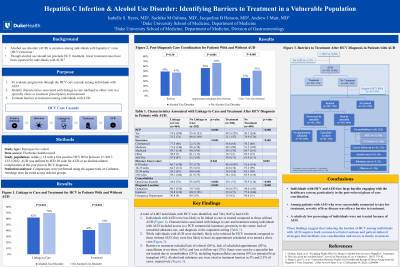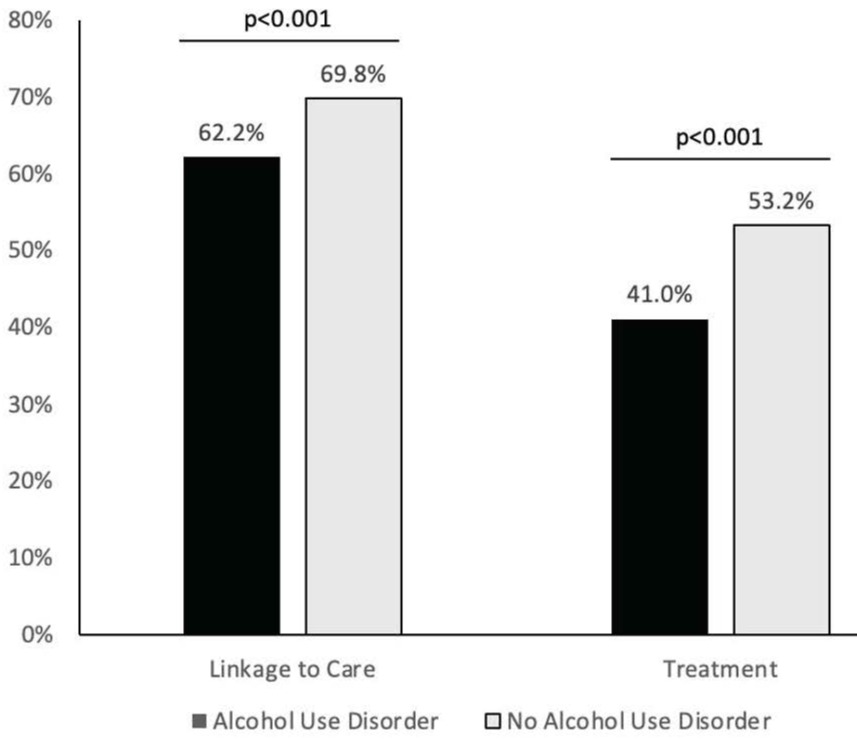Tuesday Poster Session
Category: Liver
P3765 - Hepatitis C Infection & Alcohol Use Disorder: Identifying Barriers to Treatment in a Vulnerable Population
Tuesday, October 24, 2023
10:30 AM - 4:00 PM PT
Location: Exhibit Hall

Has Audio

Isabelle S. Byers, MD
Duke University School of Medicine
Durham, NC
Presenting Author(s)
Isabelle S. Byers, MD, Sachiko M. Oshima, MD, Jacqueline B.. Henson, MD, Andrew J. Muir, MD, MHS
Duke University School of Medicine, Durham, NC
Introduction: Alcohol use disorder (AUD) is common among individuals with hepatitis C virus (HCV) infection. Although alcohol use should not preclude HCV treatment, lower treatment rates have been reported for individuals with AUD. The reasons for this remain unclear. This study aimed to evaluate the HCV care cascade and identify barriers to treatment in this population.
Methods: Adults with a first positive HCV RNA between 1/1/2017-12/31/2022 were identified at our center. AUD was defined by ICD-10 code or an alcohol-related complication in the year prior. Progression through the HCV care cascade was compared between individuals with and without AUD. Characteristics associated with linkage to care (specialty clinic visit or treatment) and treatment were evaluated. Medical records were reviewed to identify treatment barriers. Comparisons were performed using chi-square tests or Cochrane-Armitage tests for trend in ordered groups.
Results: A total of 4,003 individuals with HCV were identified, and 746 (18.6%) had AUD. Individuals with AUD were significantly less likely to be linked to care or treated compared to those without AUD (Figure). They were similarly likely to be referred for treatment (49.3% vs. 48.0%, p=0.54), though less likely to have an appointment scheduled (56.7% vs. 66.8%, p< 0.001) or be seen by a specialist (36.3% vs. 51.8%, p< 0.001). Characteristics associated with linkage to care and treatment among individuals with AUD included access to a PCP, commercial insurance, proximity to a center, lack of comorbid substance use, and diagnosis in the outpatient setting (Table). Common barriers to treatment included lack of referral (26%), lack of appointment (20%), cancelation or no-show (16%), and loss to follow-up (12%). Some were seen but not treated due to need for potential liver transplant (18%) or hepatocellular carcinoma (8%). Alcohol and substance use were cited as treatment barriers in 5% and 2.5% of cases, respectively.
Discussion: At our institution, individuals with AUD were less likely to be linked to care for HCV and receive treatment compared to individuals without AUD. Alcohol use precluded treatment in few cases, while primary barriers were instead challenges engaging with the healthcare system and severity of liver disease. Reducing the burden of HCV among individuals with AUD will require both systems-level interventions and patient-tailored strategies that facilitate transitions of care and access to timely treatment.

Disclosures:
Isabelle S. Byers, MD, Sachiko M. Oshima, MD, Jacqueline B.. Henson, MD, Andrew J. Muir, MD, MHS. P3765 - Hepatitis C Infection & Alcohol Use Disorder: Identifying Barriers to Treatment in a Vulnerable Population, ACG 2023 Annual Scientific Meeting Abstracts. Vancouver, BC, Canada: American College of Gastroenterology.
Duke University School of Medicine, Durham, NC
Introduction: Alcohol use disorder (AUD) is common among individuals with hepatitis C virus (HCV) infection. Although alcohol use should not preclude HCV treatment, lower treatment rates have been reported for individuals with AUD. The reasons for this remain unclear. This study aimed to evaluate the HCV care cascade and identify barriers to treatment in this population.
Methods: Adults with a first positive HCV RNA between 1/1/2017-12/31/2022 were identified at our center. AUD was defined by ICD-10 code or an alcohol-related complication in the year prior. Progression through the HCV care cascade was compared between individuals with and without AUD. Characteristics associated with linkage to care (specialty clinic visit or treatment) and treatment were evaluated. Medical records were reviewed to identify treatment barriers. Comparisons were performed using chi-square tests or Cochrane-Armitage tests for trend in ordered groups.
Results: A total of 4,003 individuals with HCV were identified, and 746 (18.6%) had AUD. Individuals with AUD were significantly less likely to be linked to care or treated compared to those without AUD (Figure). They were similarly likely to be referred for treatment (49.3% vs. 48.0%, p=0.54), though less likely to have an appointment scheduled (56.7% vs. 66.8%, p< 0.001) or be seen by a specialist (36.3% vs. 51.8%, p< 0.001). Characteristics associated with linkage to care and treatment among individuals with AUD included access to a PCP, commercial insurance, proximity to a center, lack of comorbid substance use, and diagnosis in the outpatient setting (Table). Common barriers to treatment included lack of referral (26%), lack of appointment (20%), cancelation or no-show (16%), and loss to follow-up (12%). Some were seen but not treated due to need for potential liver transplant (18%) or hepatocellular carcinoma (8%). Alcohol and substance use were cited as treatment barriers in 5% and 2.5% of cases, respectively.
Discussion: At our institution, individuals with AUD were less likely to be linked to care for HCV and receive treatment compared to individuals without AUD. Alcohol use precluded treatment in few cases, while primary barriers were instead challenges engaging with the healthcare system and severity of liver disease. Reducing the burden of HCV among individuals with AUD will require both systems-level interventions and patient-tailored strategies that facilitate transitions of care and access to timely treatment.

Figure: Figure. Linkage to Care and Treatment for HCV in Patients With and Without Alcohol Use Disorder
Disclosures:
Isabelle Byers indicated no relevant financial relationships.
Sachiko Oshima indicated no relevant financial relationships.
Jacqueline Henson indicated no relevant financial relationships.
Andrew Muir: Abbvie – Advisor or Review Panel Member. Gilead – Grant/Research Support.
Isabelle S. Byers, MD, Sachiko M. Oshima, MD, Jacqueline B.. Henson, MD, Andrew J. Muir, MD, MHS. P3765 - Hepatitis C Infection & Alcohol Use Disorder: Identifying Barriers to Treatment in a Vulnerable Population, ACG 2023 Annual Scientific Meeting Abstracts. Vancouver, BC, Canada: American College of Gastroenterology.
